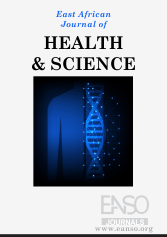Pregnancy Outcomes of Mothers with Sickle Cell Disease: A Retrospective Review of Patients Seeking Delivery Services in a Regional Referral Hospital, Western Kenya
Abstract
Background: Western Kenya has a high burden of sickle cell disease (SCD) with 4.5% of children born with sickle cell disease. We aimed to describe the demographic characteristics and pregnancy outcomes of women with SCD at Jaramogi Oginga Odinga Teaching and Referral Hospital (JOOTRH). Methods: The hospital records department retrieved all files they could identify of women who were known to have SCD and had delivered at the hospital between October 2017 and December 2022. Data was analyzed using STATA version 16.0. Results: Thirty files were retrieved representing 30 women who delivered in the hospital. The mean age was 26 (18 to 36) years. Most 14 (46.7%) had a term delivery. The maternal mean haemoglobin level was 8.72g/dl (range 5.6-13.5). Twelve (40%) had moderate hemoglobin concentration (8-10g/dl) and only 3 (10%) had severe anemia with HB below 6.5g/dl. A majority (76. %) had normal vaginal delivery. The Caesarean section rate was 23%. There was no maternal mortality; one pregnancy was a multiple birth resulting in 31 babies. Nearly all (93%) of the babies had an APGAR score of more than 7 at five minutes, 5 (16.67%) required NBU admission for various reasons, while one (3.33%) of the babies died within 24 hours of birth. Three of the women used Hydroxyurea at some point in their pregnancies and all had morphologically normal babies. Discussion: Our study findings are comparable with other case series; no maternal death was documented, however, we noted fetal outcomes which are comparable to the regional indices. Conclusion: Though pregnancy in SCD is fraught with adverse outcomes, our series demon strates that good outcomes are feasible.
Downloads
References
Carrara J, Habibi A, Benachi A, Cheminet G. Sickle cell disease and pregnancy. Presse Med. 2023;52.
McGann PT, Hernandez AG, Ware RE. Sickle cell anemia in sub-Saharan Africa: Advancing the clinical paradigm through partnerships and research. Blood. 2017;129(2):155–61.
Wanjiku CM, Njuguna F, Asirwa FC, Mbunya S, Githinji C, Roberson C, et al. Establishing care for sickle cell disease in western Kenya: Achievements and challenges. Blood Adv. 2019;3(24):8–10.
Mangla A, Moavia E, Maruvada S. Sickle Cell Anemia - StatPearls - NCBI Bookshelf [Internet]. 2019. p. 1–20. Available from: https://www.ncbi.nlm.nih.gov/books/NBK482164/
Bukhari IA, Alzahrani NM, Alanazi GA, Al-Taleb MA, AlOtaibi HS. Anemia in pregnancy: Effects on maternal and neonatal outcomes at a university hospital in Riyadh. Cureus. 2022.
Christensen T, Nardo-Marino A, Glenthøj A, Sørensen MB. Sickle cell disease and pregnancy. Ugeskr Laeger. 2021;182(6):1–8.
Smith-Whitley K. Complications in pregnant women with sickle cell disease. Hematology (United States). 2019;2019(1):359–66.
Chaturvedi S, Debaun MR. Evolution of sickle cell disease from a life-threatening disease of children to a chronic disease of adults: The last 40 years. Am J Hematol. 2016;91(1):5–14.
Soma-Pillay P, Nelson-Piercy C, Tolppanen H, Mebazaa A. Physiological changes in pregnancy. Cardiovasc J Afr. 2016;27(2):89–94.
Raman P, Gupta L. Sickle Cell Crisis. Manual of Medical Emergencies. 2001. p. 247–247.
Xiao Y, Ling Q, Yao M, Gu Y, Lan Y, Liu S, et al. Aspirin 75 mg to prevent preeclampsia in high-risk pregnancies: a retrospective real-world study in China. Eur J Med Res [Internet]. 2023;28(1):1–8. Available from: https://doi.org/10.1186/s40001-023-01024-7
Population Studies and Research Institute, National Council for Population and Development, UNFPA. Differential Maternal Mortality in Kenya: the need to prioritize Interventions. Policy Br [Internet]. 2013;38(38):2008–11. Available from: https://ncpd.go.ke/wp-content/uploads/2021/02/Policy-Brief-38-Differential-Maternal-Mortality-in-Kenya.pdf
Muchemi OM, Echoka E, Makokha A. Factors associated with low birth weight among neonates born at Olkalou district hospital, central region, Pan Afr Med J. 2015;20:1–7.
Galiba Atipo Tsiba FO, Itoua C, Ehourossika C, Ngakegni NY, Buambo G, Potokoue Mpia NSB, et al. Pregnancy Outcomes among Patients with Sickle Cell Disease in Brazzaville. Anemia. 2020;2020: 1-7.
Aghamolaei T, Pormehr-Yabandeh A, Hosseini Z, Roozbeh N, Arian M, Ghanbarnezhad A. Pregnancy in the Sickle Cell Disease and Fetomaternal Outcomes in Different Sickle Cell Genotypes: A Systematic Review and Meta-Analysis. Ethiop J Health Sci. 2022;32(4):849–64.
Oteng-Ntim E, Pavord S, Howard R, Robinson S, Oakley L, Mackillop L, et al. Management of sickle cell disease in pregnancy. A British Society for Haematology Guideline. Br J Haematol. 2021;194(6):980–95.
Oakley LL, Mitchell S, von Rege I, Hadebe R, Howard J, Robinson SE, et al. Perinatal outcomes in women with sickle cell disease: a matched cohort study from London, UK. Br J Haematol. 2022;196(6):1069–75.
Muganyizi PS, Kidanto H. Sickle Cell Disease in Pregnancy: Trend and Pregnancy Outcomes at a Tertiary Hospital in Tanzania. PLoS One. 2013;8(2):e56541.
Silva-Pinto AC, Ladeira S de OD, Brunetta DM, De Santis GC, Angulo I de L, Covas DT. Sickle cell disease and pregnancy: Analysis of 34 patients followed at the Regional Blood Center of Ribeirão Preto, Brazil. Rev Bras Hematol Hemoter [Internet]. 2014;36(5):329–33. Available from: http://dx.doi.org/10.1016/j.bjhh.2014.07.002
Christensen T, Nardo-Marino A, Glenthøj A, Sørensen MB. Sickle cell disease and pregnancy. Ugeskr Laeger. 2020;182(43):1–8.
Early ML, Eke AC, Gemmill A, Lanzkron S, Pecker LH. Severe Maternal Morbidity and Mortality in Sickle Cell Disease in the National Inpatient Sample, 2012-2018. Vol. 6, JAMA Network Open. 2023. p. E2254552.
Kroner BL, Hankins JS, Pugh N, Kutlar A, King AA, Shah NR, et al. Pregnancy outcomes with hydroxyurea use in women with sickle cell disease. Am J Hematol. 2022;97(5):603–12.
Copyright (c) 2025 Khadija Hussein, Stephen Gwer, Willis Ochieng, Steven O. Tolo, Valentine lulana Munialo, Dickson Ngala

This work is licensed under a Creative Commons Attribution 4.0 International License.




























